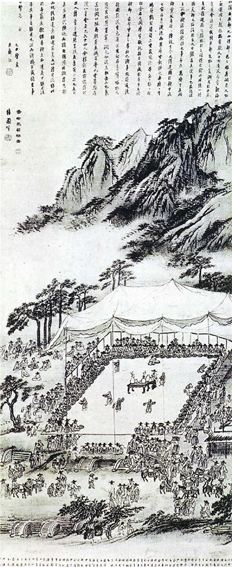Chosŏn'gŭl 만월대 Revised Romanization Manwoldae | Hancha 滿月臺 McCune–Reischauer Manwŏltae | |
 | ||
Address Kaesŏng, North Hwanghae, North Korea Similar Tomb of King Kongmin, Sonjuk Bridge, Tomb of King Wanggon, Namdaemun, Anhak Palace | ||
Peninsula inside ep33 inter korean joint excavation project at manwoldae
Manwŏltae Palace was the official royal palace of the Goryeo Dynasty. Located in the ancient capital city of Kaesŏng, the palace was completely destroyed during the Red Turbans invasions of Korea during the 14th century.
Contents
- Peninsula inside ep33 inter korean joint excavation project at manwoldae
- History
- Description
- Excavations and findings
- References
History
Construction on the palace began in 919, at the beginning of the Goryo dynasty; it was built south of the Songak Mountains for good Feng Shui. The palace was divided into two major sections; the Kungsŏng (궁성, 宮城), where the king and royal family resided, and the Hwangsŏng (황성, 皇城), where affairs of state were conducted. Large buildings such as the Changhwa (장화전, 長和殿), and Wŏndŏk (원덕전, 元德殿) Halls contained shrines and living quarters, while Hoegyŏng Hall (회경전, 會慶殿), the largest and most impressive, contained the throne room. The complex also contained a stone astronomy tower known as the Chŏmsŏngdae (첨성대, 瞻星臺), which was used by royal astrologers. The palace was burned to the ground in 1361 when the Red Turbans invasions of Korea, sacking the city of Kaesong and forcing the king to temporary flee Andong. Contemporary records describe the palace to as containing buildings of immense proportions similar to the building sizes found in the Forbidden City. The architectural style and decoration is said to have followed the uniquely Korean royal color palette called Dancheong which is seen in other Korean palaces that still stand today. However, Mandoldae Palace is described to have contained many multistory buildings, more gold embellishments, blue and white as compared to the surviving Korean Palaces from Korea's more recent Confucian Joeson Dynasty, which stressed humility and restrain in all things. Therefore, Manwoldae gives us valuable insight into another distinct form of Korean palace architecture that had been forgotten due to foreign invasions and presently the location of these palace sites in the secluded Democratic Peoples Republic of Korea.
Description
The palace is thought to have had blue celadon roof tiles, similar to other excavated tiles dating from the same period.
Excavations and findings
Excavation of the ruins of Manwoldae Palace began under the supervision of the North Korean government, but merged into a joint Korean cultural project. Many valuable relics of the late Goryeo period have been uncovered at the site, including ceramics, metal items, ancestral tablets, mirrors, and over 3,000 roofing tiles. It is on a list of locations planned by North Korea to become UNESCO World Heritage Sites. As of 2015, both Koreas have conducted six rounds of joint excavations of the site since 2007; the 2015 round of excavations will last 6 months, the longest excavation period to date.
A 25 cm celadon jar with an inlaid monkey and tree design in an underglaze of gold found at the site is held at the National Museum of Korea.
Excavation at the site uncovered a "unique" two-feet vase-like cylinder made from celadon. The object’s function was still unclear as of June 2015. The vase-like object bears an intricate pattern of peonies and vines and it used to have holes at the top and bottom; it was speculated to have been a flower pot or a vessel used for some ceremonial purpose. A modern South Korean celadon maker explains "the piece is unique because of its size. Due to the nature of the celadon ceramics, an object of this size would be very difficult to bake properly, even more difficult than smaller items that often emerge broken or bent from the furnace."
In November 2015, the excavation had unearthed a piece of metal type, with initial reports dating it from Goryeo Dynasty, but it requires further study to verify when it was made. Researchers hope to radiocarbon date the object. They are to study when it was made, what kind of font was used, and what it is made of. There are traces of ink on the type.
